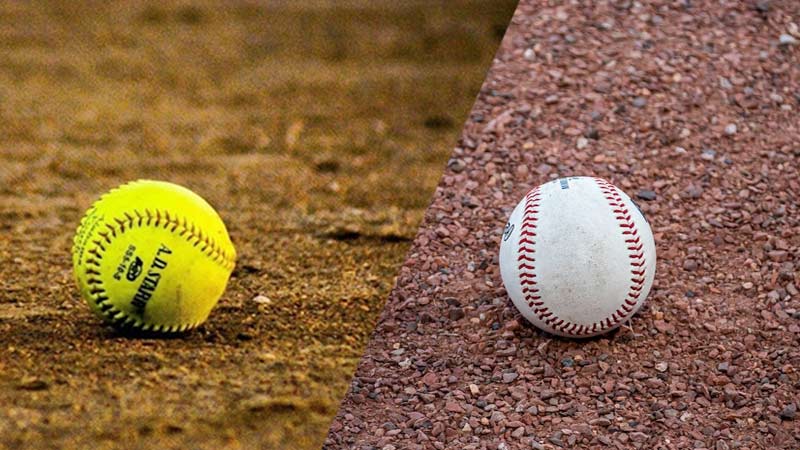Softball and baseball are two popular sports with similarities in gameplay but distinct differences in rules and regulations.
The nuances of each sport are essential for players, fans, and enthusiasts. In this comprehensive blog post, we will explore ten specific differences between softball and baseball rules, providing detailed explanations for each point.
From field size to pitching style, and base stealing to designated hitters, this article aims to shed light on the contrasting elements of these beloved sports and offer insights into their unique rule structures. Sit tight and read the whole article, please.
10 Specific Differences Between Softball and Baseball Rules
Let’s check out the hand-picked 10 specific differences between Softball and Baseball rules. Check them out below.
Field Size
The difference in field size between softball and baseball has significant implications for the gameplay. Softball fields have shorter base paths, which means players have less time to reach each base.
The smaller outfield area in softball requires outfielders to cover less ground, resulting in different defensive strategies compared to baseball. Additionally, the smaller field size in softball often leads to more infield plays and a faster-paced game.
Pitching Distance
The pitching distance plays a crucial role in the dynamics of the game. The shorter pitching distance in softball means that hitters have less time to react to the pitch.
This emphasizes the importance of quick decision-making and timing for softball hitters. On the other hand, the longer pitching distance in baseball provides hitters with slightly more time to see and adjust to the pitch.
Pitching Style
The underhand pitching style in softball, with the ball released below the waist, creates a different trajectory and movement compared to the overhand or sidearm motion in baseball.
The different pitching styles require hitters to make adjustments in their timing and approach at the plate. The underhand pitch in softball can result in more riseballs, drops, and change-ups, adding a unique dimension to the game.
Ball Size
The size of the ball in softball and baseball affects various aspects of the game. The larger softball requires pitchers to use different grips and spins, leading to variations in pitch movement.
Fielders and catchers in softball must also adjust to the larger ball size when receiving throws and making catches. The smaller baseball is generally easier to handle and allows for different pitch types and speeds.
Pitching Delivery
The pitching delivery rules distinguish between softball and baseball. In softball, the pitcher must keep both feet in contact with the pitching rubber at the start of the pitch and deliver the ball in a continuous motion.
In baseball, pitchers have the option of using a wind-up or a stretch position. The difference in pitching delivery rules affects the timing and mechanics of the pitcher’s motion, as well as the timing and approach of the hitters.

Number of Players
Softball teams typically have ten players on the field, while baseball teams consist of nine players. The additional player in softball is often positioned as a short center fielder, providing extra coverage in the outfield.
This difference in player count can influence defensive alignments and strategies in each sport.
Base Stealing
Base stealing rules differ between softball and baseball. In softball, runners cannot leave the base until the ball leaves the pitcher’s hand. This rule restricts the timing and opportunity for stealing bases in softball, making it more challenging for runners to gain an advantage.
In baseball, runners can attempt to steal bases at any time, creating more strategic opportunities for baserunning.
Designated Hitter (DH)
The designated hitter (DH) rule is a key difference between softball and baseball. In baseball, the designated hitter can bat in place of the pitcher, allowing for a specialized hitter in the lineup.
However, in softball, the pitcher is typically part of the batting lineup and must contribute offensively.
The absence of the DH in softball places a greater emphasis on the pitcher’s ability to handle both pitching and hitting responsibilities.
Lead Offs
Baseball allows base runners to take leads off the base, providing them with a head start in stealing bases or advancing on hits. In softball, runners must remain in contact with the base until the pitch crosses the plate.
The lead-off rule difference impacts base running strategies and the timing of steals and advances in each sport.
Game Duration
Softball games often have a time limit, typically consisting of seven innings, while baseball games typically consist of nine innings. The shorter game duration in softball necessitates quicker decision-making and intensifies the importance of each inning.
In contrast, baseball games have a longer duration, allowing for more strategic planning and adjustments throughout the game
These specific rule differences highlight the unique aspects of softball and baseball, contributing to the distinct strategies and gameplay observed in each sport.
Which Is More Strict: Baseball or Softball Rules?
Determining which sport has stricter rules baseball and softball is subjective, as it depends on various factors. However, it is worth exploring some key differences in rules and their enforcement. Here are a few subheadings to elaborate on this topic:
Base Stealing Restrictions
Softball has limitations on base stealing. Runners cannot leave the base until the pitcher releases the ball, which can restrict the strategic element of stealing bases.
In baseball, runners can attempt to steal a base at any time, which adds a different dynamic to the game.
Pitching Motion Regulations
Softball has stricter regulations on pitching motions. The pitcher must have both feet on the pitching rubber at the start of the pitch and must release the ball in an underhand motion.
In baseball, pitchers have more flexibility in their delivery, allowing for a wider range of pitching styles and arm angles.
Umpire Interpretation
The interpretation and enforcement of rules can vary among umpires in both sports. While there are rule books to provide guidelines, there may be slight variations in how rules are applied or interpreted, which can influence the perceived strictness of the game.
Level of Play
The level of play can also impact the strictness of rules. Professional or higher-level baseball and softball games tend to have stricter enforcement of rules compared to recreational or youth leagues.
The focus on fair play and adherence to rules may vary depending on the competitive context.
Is Baseball Easier than Softball?
The difficulty level of baseball and softball is subjective and can vary based on individual preferences and skill sets. Here are some subheadings to elaborate on this topic:
Pitching and Hitting Challenges
Baseball typically involves a longer pitching distance and a smaller ball, which can require more power and precision in both pitching and hitting.
Softball, on the other hand, features a shorter pitching distance and a larger ball, which may demand quick reflexes and adaptability at the plate.
Field Size and Reaction Time
Baseball fields are larger than softball fields, requiring players to cover more ground and allowing for longer throws. Softball fields are smaller, which can result in faster-paced games and shorter reaction times for fielders.
Skill Set Preference
The perception of which sport is easier can depend on individual preferences and strengths. Some players may find baseball’s longer distances and smaller target areas more challenging, while others may excel at softball’s quick reactions and strategic aspects.
Personal Experience
Familiarity and experience with a particular sport can influence its perceived difficulty. Players who have grown up playing baseball may find it easier due to years of practice and familiarity with the nuances of the game.
Similarly, softball players may have an advantage in their chosen sport.
In conclusion, the perceived strictness of rules and the relative difficulty of baseball and softball are subjective and depend on various factors.
Both sports have their unique challenges and skill requirements, and individual preferences and experiences play a significant role in determining which sport is considered easier or stricter.
FAQs
Can a softball pitcher switch to baseball pitching or vice versa?
While there may be similarities in pitching mechanics, transitioning from softball pitching to baseball pitching (or vice versa) can be challenging due to differences in pitching distance, ball size, and pitching style.
It requires adaptation and significant practice to adjust to the specific demands of each sport.
Are the dimensions of the infield the same in softball and baseball?
The dimensions of the infield in softball and baseball are not the same. Softball infields are generally smaller, with shorter base paths and reduced distances between bases compared to baseball.
Can softball players play baseball, and vice versa?
Softball players can play baseball, and vice versa, as both sports involve similar fundamental skills. However, transitioning between the two sports may require adjustments in terms of rules, equipment, and technique.
Why is base stealing more restricted in softball?
Base stealing is more restricted in softball to balance the advantage that pitchers have in the underhand pitching motion. By limiting base stealing, the sport aims to maintain a fair balance between offense and defense.
Are the pitching mounds the same in softball and baseball?
The pitching mounds in softball and baseball differ in terms of distance and height. Softball pitching mounds are closer to home plate and lower in height compared to baseball mounds.
End Call
Softball and baseball may share common roots, but they possess distinct rule variations that contribute to the unique experiences offered by each sport.
The key differences, such as field size, pitching distances, base stealing rules, and designated hitters, help players, coaches, and fans appreciate the intricacies of these beloved sports.
While both softball and baseball have their challenges and intricacies, they provide exciting opportunities for players to showcase their skills and enjoy the thrill of the game. Thank you for your time.







